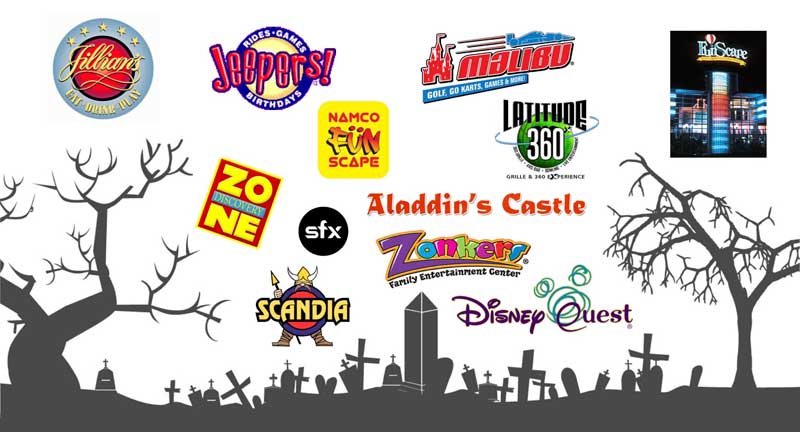
Vol. XVI, No. 7, June/July 2016
- Editor's Corner
- Quite a change in a quarter century
- Go from 'stupid' to 'stupendous' in 3 days
- A business model built on quicksand; history continues to repeat itself
- Eight years and counting
- Bowling; a tale of two worlds update
- Who are the early adopters of new technology?
- An industry paralyzed by tunnel vision
- Pokémon Go a watershed moment
A business model built on quicksand; history continues to repeat itself
Our company is now in its 27th year. Over those years we have seen many family entertainment centers (FECs) and other type community leisure venues (CLVs) come and go. It is amazing how history continues to repeat itself with so many new centers continuing to build their business model on quicksand, which greatly increases their likely demise.

Here's the basic investment challenge CLVs face. For a venue that is leasing its space, it generally needs to generate a 20% or higher cash-on-cash return on cost to be viable. When the investment includes the real estate investment as well (the land and building), the hybrid return of real estate and the business needs to be in the mid-teens. For sake of example, we will examine the rental model.
So let's say the CLV cost $2.0 million to develop. At a 20% return, it would generate $400,000 in annual cash flow. So over five years, the cash flow would total $2.0 million. Sounds great, doesn't it? But wait a minute! All it has done is get the initial investment back after five years. It has only broken even with a lot of work and often worries by its owner to get there. If we had just invested the $2.0 million in U.S. 5-year Treasury Notes, we would have been better off at the end of five years. At an interest rate of only 1.0%, at the end of five years we would have gotten back the $2.0 million plus an additional $100,000 with virtually no risk, work or worry.
So with this CLV example, it needs to generate a return far beyond five years to be considered a profitable investment. Obviously that means a business model that has longevity.
Continually chasing after the “next big thing”
So here's how many CLVs and most FECs historically, and even today, continue to build their business models on quicksand. They fail to have a mix that has longevity, that will give them returns on investment beyond just getting all the investment back (many don't even make it that far). The attractions, or a large share of their attractions, have short lives, typically around three years at best. So now they have to hope they can find the next big thing to bring in, and that costs money, upsetting the whole investment equation.
Using our example of the $2.0 million CLV, if at the end of three years it has to invest in a new $200,000 attraction, that now means the total investment is $2.2 million. So even if the annual return continues at $400,000, it will now take 5.5 years to just break even. And just after it breaks even, in year six using the three-year attraction life, it will need to invest again, so the investment goes up and the return declines.
Unfortunately, what has happened to so many FECs is that few if any of their original attractions had legs, so it takes a much larger investment than $200,000 to make them attractive again. And for many, by the time they realized they are about to sink into the quicksand, they didn't have the cash flow or capital to reinvest, so they joined the FEC graveyard.

Hoping you can find and afford the next big thing every few years to keep the FEC successful is not a very viable long-term business model. It's the quicksand model to failure.
Just a few examples of the attractions we have seen have short lives in family entertainment centers over our more than quarter century in the industry include soft-contained-play, indoor and outdoor iron rides, climbing walls, billiards, inflatables and a combination of indoor rides and games. Today a few of the latest next big things for FEC venues are ropes courses, glow golf and zip lines. We think history will soon repeat itself, as it is highly unlikely these next big things will prove to have the longevity in an FEC environment that is needed for a long-term return.
It is most unfortunate that many new CLV developers are not aware of the history lesson of not building their business model on attractions that do not have longevity. So they set themselves up for poor performance, even failure over the long term. What is worse is that so many industry consultants continue to advise their clients to follow the quicksand business model.
So over those same 27 years, while we've seen so many attractions come and go and FECs fail, there are still CLV models that have had long lives. Why? Because they were built on attractions that have stood the test of time where you don't have to be continually chasing after the next big thing. Some of those evergreens are bowling, laser tag and food and beverage. Yes, you read that correctly. Food and beverage can be an anchor attraction. In fact, for the concepts that have stood the test of time for over 30 years, food and beverage has been 40% to 50% or more of their total revenues.
In the mix of those long-term concepts, you often find gamerooms. Large predominately redemption gamerooms can be considered an attraction in many situations such as at Dave & Buster's, Chuck E. Cheese's and Peter Piper Pizza. Gamerooms, however, have an economic model somewhat different than other attractions. For gamerooms to stay attractive, there needs to be continual reinvestment in new games. Unlike other attractions with short lives, the financial model works for gamerooms as properly selected games generate much higher returns than other attractions, so they earn back their investment much faster and continue to do so before they need to be replaced. Also, there is always as supply of new games to replace the old, unlike attractions where the next big thing is never assured.
Times have changed; the future isn't what it use to be
Not only what the attractions are, but also how they are served up affects longevity. Let's look at bowling. Our company's very first project back in 1989 was designing and managing the rebuilding of a bowling alley that had burned to the ground. Back then bowling catered predominately to leagues who would generate up to 75% of the revenues. It's hard to believe that back then people would sign up to show up every Tuesday at 5pm for 30 or more weeks. No, 30 weeks is not a typo. Heck today, it's hard to get people to commit to something next week.
Over time as society has changed, leagues have died off, now accounting for less then 20% of bowling's revenues (there are still some strong blue-collar pockets where old alleys are still predominately league houses). Now, the most successful bowling-based CLVs cater to walk-in casual bowlers and groups, and a more upscale crowd. These new school CLVs feature far different upscale and social seating than the settee seating from the league bowling alley days and they have far better and quality food and drink. But the lanes haven't changed.
Who you serve the attractions up to also affects longevity. Back in the earlier days of FECs, developers designed their centers to serve middle-class families (that's where the industry identity of FEC came from), which they interpreted to mean a little bit of something for everyone. That however, has not panned out to be a very successful model, as many of the graveyard centers learned the expensive way. When you try to be a little bit of something for everyone, you end up not being special to anyone, especially today with so many out-of-home leisure options that target specific demographics and type experiences. And today, the middle class has shrunk as a percentage of the population, and are financially squeezed while college educated, higher socioeconomic households account for 70% of all out-of-home entertainment spending at community venues. These more upscale customers demand finishes, ambiance and quality higher than a middle class standard. Surprisingly, the FEC paradigm continues to drive much of the industry, including two internationally owned U.S. chains (that will remain unnamed to protect the guilty) that are rolling yesterday's model out across the country, as history's lessons seem to have been forgotten.
Paradigms die hard. In fact the early paradigms of the FEC industry of developing a mix without longevity where you are continually chasing the next big thing, offering a little bit of something for everyone and targeting the middle class, continues to plague the industry as so many new centers continue to be developed on a business model built on quicksand and times long past.
Vol. XVI, No. 7, June/July 2016
- Editor's Corner
- Quite a change in a quarter century
- Go from 'stupid' to 'stupendous' in 3 days
- A business model built on quicksand; history continues to repeat itself
- Eight years and counting
- Bowling; a tale of two worlds update
- Who are the early adopters of new technology?
- An industry paralyzed by tunnel vision
- Pokémon Go a watershed moment



